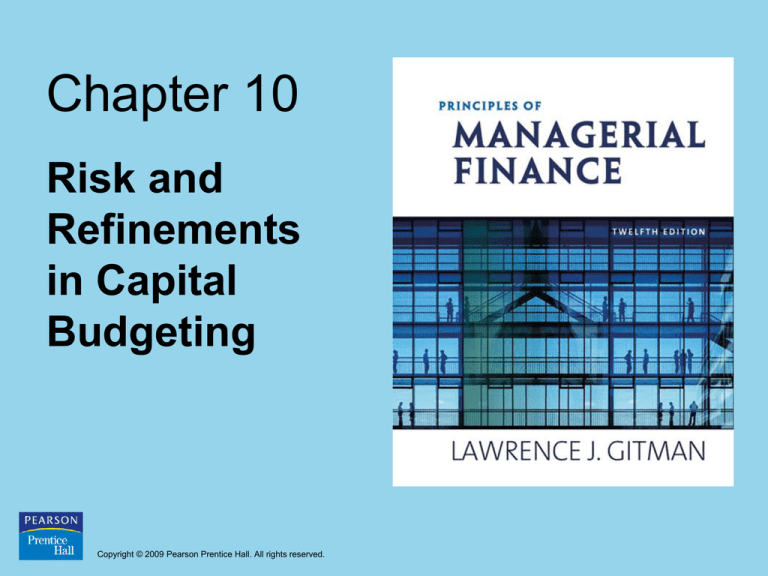
Chapter 10
Risk and
Refinements
in Capital
Budgeting
Copyright © 2009 Pearson Prentice Hall. All rights reserved.
Learning Goals
1. Understand the importance of recognizing risk
in the analysis of capital budgeting projects.
2. Discuss breakeven cash inflow, scenario
analysis, and simulation as behavioral
approaches for dealing with risk.
3. Discuss the unique risks that multinational
companies face.
Copyright © 2009 Pearson Prentice Hall. All rights reserved.
10-2
Learning Goals (cont.)
4. Describe the determination and use of risk-adjusted
discount rates (RADRs), portfolio effects, and the
practical aspects of RADRs.
5. Select the best of a group of mutually exclusive
projects using annualized net present values (ANPVs).
6. Explain the role of real options and the objective and
procedures for selecting projects under capital
rationing.
Copyright © 2009 Pearson Prentice Hall. All rights reserved.
10-3
Introduction to Risk
in Capital Budgeting
• Thus far in our exploration of capital budgeting, all
projects were assumed to be equally risky.
• The acceptance of any project would not alter the firm’s
overall risk.
• In actuality, these situations are rare—project cash
flows typically have different levels of risk and the
acceptance of a project does affect the firm’s overall
risk.
• This chapter will focus on how to handle risk.
Copyright © 2009 Pearson Prentice Hall. All rights reserved.
10-4
Introduction to Risk
in Capital Budgeting (cont.)
Table 10.1 Cash Flows and NPVs for Bennett Company’s
Projects
Copyright © 2009 Pearson Prentice Hall. All rights reserved.
10-5
Behavioral Approaches
for Dealing with Risk
• In the context of the capital budgeting projects
discussed in this chapter, risk results almost entirely
from the uncertainty about future cash inflows,
because the initial cash outflow is generally known.
• These risks result from a variety of factors including
uncertainty about future revenues, expenditures and
taxes.
• Therefore, to asses the risk of a potential project, the
analyst needs to evaluate the riskiness of the cash
inflows.
Copyright © 2009 Pearson Prentice Hall. All rights reserved.
10-6
Behavioral Approaches for Dealing
with Risk: Risk and Cash Inflows
Treadwell Tire, a tire retailer with a 10% cost of capital, is
considering investing in either of two mutually exclusive
projects, A and B. Each requires a $10,000 initial
investment, and both are expected to provide equal
annual cash inflows over their 15-year lives. For either
project to be acceptable, NPV must be greater than zero.
We can solve for CF using the following:
Copyright © 2009 Pearson Prentice Hall. All rights reserved.
10-7
Behavioral Approaches for Dealing
with Risk: Risk and Cash Inflows (cont.)
Copyright © 2009 Pearson Prentice Hall. All rights reserved.
10-8
Behavioral Approaches for Dealing
with Risk: Sensitivity Analysis
The risk of Treadwell Tire Company’s investments can be
evaluated using sensitivity analysis as shown in Table 10.2
on the following slide. For this example, assume that the
financial manager made pessimistic, most likely, and
optimistic estimates of the cash inflows for each project.
Copyright © 2009 Pearson Prentice Hall. All rights reserved.
10-9
Behavioral Approaches for Dealing
with Risk: Sensitivity Analysis (cont.)
Table 10.2
Scenario
Analysis of
Treadwell’s
Projects A
and B
Copyright © 2009 Pearson Prentice Hall. All rights reserved.
10-10
Behavioral Approaches for Dealing
with Risk: Scenario Analysis
• Scenario analysis is a behavioral approach similar to
sensitivity analysis but is broader in scope.
• This method evaluates the impact on the firm’s return
of simultaneous changes in a number of variables, such
as cash inflows, outflows, and the cost of capital.
• NPV is then calculated under each different set of
variable assumptions.
Copyright © 2009 Pearson Prentice Hall. All rights reserved.
10-11
Behavioral Approaches for Dealing
with Risk: Simulation
• Simulation is a statistically-based behavioral approach
that applies predetermined probability distributions and
random numbers to estimate risky outcomes.
• Figure 10.1 presents a flowchart of the simulation of
the NPV of a project.
• The use of computers has made the use of simulation
economically feasible, and the resulting output provides
an excellent basis for decision-making.
Copyright © 2009 Pearson Prentice Hall. All rights reserved.
10-12
Behavioral Approaches
for Dealing with Risk
Figure 10.1
NPV
Simulation
Copyright © 2009 Pearson Prentice Hall. All rights reserved.
10-13
International Risk Considerations
• Exchange rate risk is the risk that an unexpected
change in the exchange rate will reduce NPV of a
project’s cash flows.
• In the short term, much of this risk can be hedged by
using financial instruments such as foreign currency
futures and options.
• Long-term exchange rate risk can best be minimized by
financing the project in whole or in part in the local
currency.
Copyright © 2009 Pearson Prentice Hall. All rights reserved.
10-14
International
Risk Considerations (cont.)
• Political risk is much harder to protect against once a
project is implemented.
• A foreign government can block repatriation of profits
and even seize the firm’s assets.
• Accounting for these risks can be accomplished by
adjusting the rate used to discount cash flows—or
better—by adjusting the project’s cash flows.
Copyright © 2009 Pearson Prentice Hall. All rights reserved.
10-15
International
Risk Considerations (cont.)
• Since a great deal of cross-border trade among
MNCs takes place between subsidiaries, it is
also important to determine the net incremental
impact of a project’s cash flows overall.
• As a result, it is important to approach
international capital projects from a strategic
viewpoint rather than from a strictly financial
perspective.
Copyright © 2009 Pearson Prentice Hall. All rights reserved.
10-16
Risk-Adjusted Discount Rates
• Risk-adjusted discount rates are rates of return that
must be earned on given projects to compensate the
firm’s owners adequately—that is, to maintain or
improve the firm’s share price.
• The higher the risk of a project, the higher the RADR—
and thus the lower a project’s NPV.
Copyright © 2009 Pearson Prentice Hall. All rights reserved.
10-17
Risk-Adjusted Discount Rates:
Review of CAPM
Copyright © 2009 Pearson Prentice Hall. All rights reserved.
10-18
Risk-Adjusted Discount Rates:
Using CAPM to Find RADRs
Figure 10.2 CAPM and SML
Insert Figure 10.2 here
Copyright © 2009 Pearson Prentice Hall. All rights reserved.
10-19
Risk-Adjusted Discount Rates: Applying
RADRs
Bennett Company wishes to apply the Risk-Adjusted
Discount Rate (RADR) approach to determine whether to
implement Project A or B. In addition to the data
presented earlier, Bennett’s management assigned a
“risk index” of 1.6 to project A and 1.0 to project B as
indicated in the following table. The required rates of
return associated with these indexes are then applied as
the discount rates to the two projects to determine NPV.
Copyright © 2009 Pearson Prentice Hall. All rights reserved.
10-20
Risk-Adjusted Discount Rates: Applying
RADRs (cont.)
Copyright © 2009 Pearson Prentice Hall. All rights reserved.
10-21
Risk-Adjusted Discount Rates: Applying
RADRs (cont.)
Figure 10.3 Calculation of NPVs for Bennett Company’s
Capital Expenditure Alternatives Using RADRs
Copyright © 2009 Pearson Prentice Hall. All rights reserved.
10-22
Risk-Adjusted Discount Rates:
RADRs in Practice
Table 10.3 Bennett Company’s Risk Classes and RADRs
Copyright © 2009 Pearson Prentice Hall. All rights reserved.
10-23
Risk-Adjustment Techniques:
Portfolio Effects
• As noted earlier, individual investors must hold diversified
portfolios because they are not rewarded for assuming
diversifiable risk.
• Because business firms can be viewed as portfolios of assets, it
would seem that it is also important that they too hold diversified
portfolios.
• Surprisingly, however, empirical evidence suggests that firm
value is not affected by diversification.
• In other words, diversification is not normally rewarded and
therefore is generally not necessary.
Copyright © 2009 Pearson Prentice Hall. All rights reserved.
10-24
Risk-Adjustment Techniques:
Portfolio Effects (cont.)
• It turns out that firms are not rewarded for
diversification because investors can do so
themselves.
• An investor can diversify more readily, easily,
and costlessly simply by holding portfolios of
stocks.
Copyright © 2009 Pearson Prentice Hall. All rights reserved.
10-25
Capital Budgeting Refinements:
Comparing Projects With Unequal Lives
• If projects are independent, comparing projects with
unequal lives is not critical.
• But when unequal-lived projects are mutually
exclusive, the impact of differing lives must be
considered because they do not provide service over
comparable time periods.
• This is particularly important when continuing service
is needed from the projects under consideration.
Copyright © 2009 Pearson Prentice Hall. All rights reserved.
10-26
Capital Budgeting Refinements: Comparing
Projects With Unequal Lives (cont.)
The AT Company, a regional cable-TV firm, is evaluating
two projects, X and Y. The projects’ cash flows and
resulting NPVs at a cost of capital of 10% is given below.
Copyright © 2009 Pearson Prentice Hall. All rights reserved.
10-27
Capital Budgeting Refinements: Comparing
Projects With Unequal Lives (cont.)
The AT Company, a regional cable-TV firm, is evaluating
two projects, X and Y. The projects’ cash flows and
resulting NPVs at a cost of capital of 10% is given below.
Copyright © 2009 Pearson Prentice Hall. All rights reserved.
10-28
Capital Budgeting Refinements: Comparing
Projects With Unequal Lives (cont.)
Ignoring the difference in their useful lives, both projects are
acceptable (have positive NPVs). Furthermore, if the projects
were mutually exclusive, project Y would be preferred over
project X. However, it is important to recognize that at the end
of its 3 year life, project Y must be replaced, or renewed.
Although a number of approaches are available for
dealing with unequal lives, we will present the most
efficient technique -- the annualized NPV approach.
Copyright © 2009 Pearson Prentice Hall. All rights reserved.
10-29
Capital Budgeting Refinements: Comparing
Projects With Unequal Lives (cont.)
Annualized NPV (ANPV)
The ANPV approach converts the NPV of unequal-lived
mutually exclusive projects into an equivalent (in NPV terms)
annual amount that can be used to select the best project.
1. Calculate the NPV of each project over its live using the
appropriate cost of capital.
2. Divide the NPV of each positive NPV project by the
PVIFA at the given cost of capital and the project’s live
to get the ANPV for each project.
3. Select the project with the highest ANPV.
Copyright © 2009 Pearson Prentice Hall. All rights reserved.
10-30
Capital Budgeting Refinements: Comparing
Projects With Unequal Lives (cont.)
Annualized NPV (ANPV)
1. Calculate the NPV for projects X and Y at 10%.
NPVX = $11,248; NPVY = $18,985.
2. Calculate the ANPV for Projects X and Y.
ANPVX = $11,248/PVIFA10%,3 years = $4,523
ANPVY = $18,985/PVIFA10%,6 years = $4,359
3. Choose the project with the higher ANPV.
Pick project X.
Copyright © 2009 Pearson Prentice Hall. All rights reserved.
10-31
Recognizing Real Options
• Real options are opportunities that are embedded in
capital projects that enable managers to alter their cash
flows and risk in a way that affects project acceptability
(NPV).
• Real options are also sometimes referred to as strategic
options.
• Some of the more common types of real options are
described in the table on the following slide.
Copyright © 2009 Pearson Prentice Hall. All rights reserved.
10-32
Recognizing Real Options (cont.)
Table 10.4 Major Types of Real Options
Copyright © 2009 Pearson Prentice Hall. All rights reserved.
10-33
Recognizing Real Options (cont.)
NPVstrategic = NPVtraditional + Value of Real Options
Assume that a strategic analysis of Bennett Company’s
projects A and B (see Table 10.1) finds no real options
embedded in Project A but two real options embedded
in B:
1. During it’s first two years, B would have downtime that
results in unused production capacity that could be used
to perform contract manufacturing;
2. Project B’s computerized control system could control two
other machines, thereby reducing labor costs.
Copyright © 2009 Pearson Prentice Hall. All rights reserved.
10-34
Recognizing Real Options (cont.)
Bennett’s management estimated the NPV of the contract manufacturing
option to be $1,500 and the NPV of the computer control sharing option to
be $2,000. Furthermore, they felt there was a 60% chance that the
contract manufacturing option would be exercised and a 30% chance that
the computer control sharing option would be exercised.
Value of Real Options for B = (60% x $1,500) + (30% x $2,000)
$900 + $600 = $1,500
NPVstrategic = $10,924 + $1,500 = $12,424
NPVA = $12,424; NPVB = $11,071; Now choose A over B.
Copyright © 2009 Pearson Prentice Hall. All rights reserved.
10-35
Capital Rationing
• Firm’s often operate under conditions of capital rationing—they
have more acceptable independent projects than they can fund.
• In theory, capital rationing should not exist—firms should
accept all projects that have positive NPVs.
• However, research has found that management internally
imposes capital expenditure constraints to avoid what it deems to
be “excessive” levels of new financing, particularly debt.
• Thus, the objective of capital rationing is to select the group of
projects within the firm’s budget that provides the highest overall
NPV or IRR.
Copyright © 2009 Pearson Prentice Hall. All rights reserved.
10-36
Capital Rationing
Tate Company, a fast growing plastics company with a
cost of capital of 10%, is confronted with six projects
competing for its fixed budget of $250,000. The initial
investment and IRR for each project are shown below:
Copyright © 2009 Pearson Prentice Hall. All rights reserved.
10-37
Capital Rationing: IRR Approach
Figure 10.4 Investment Opportunities Schedule
Copyright © 2009 Pearson Prentice Hall. All rights reserved.
10-38
Capital Rationing: NPV Approach
Table 10.5 Rankings for Tate Company Projects
Copyright © 2009 Pearson Prentice Hall. All rights reserved.
10-39








